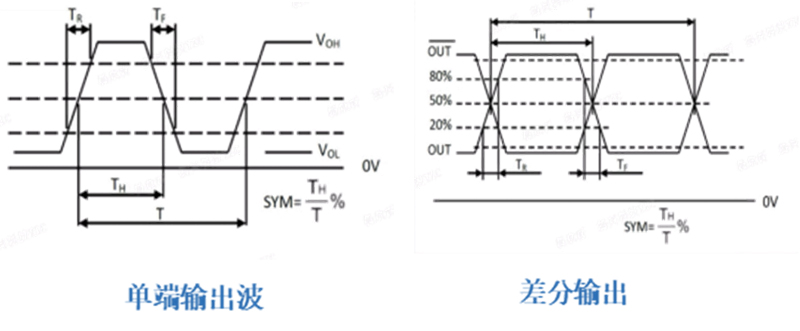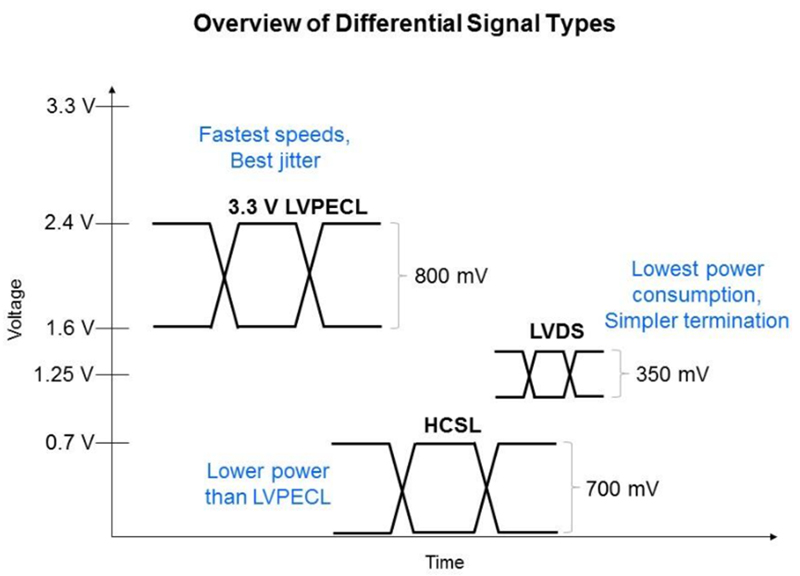Differential crystal oscillators are oscillators that can output differential signals. Differential signals use the numerical difference between two physical quantities to represent a signal. Specifically, differential crystal oscillators send two signals of equal magnitude and opposite direction, and the receiving end determines whether the logical bit is 0 or 1 by comparing the difference between the two signals. This differential signal approach can eliminate common-mode noise and produce a higher-performance system. Differential crystal oscillators are widely used in clock oscillating circuits in computers, communication devices, and other electronic devices, clock recovery and data synchronization circuits in data communication, frequency synthesizers and local oscillators in wireless communication systems, clocks, counters, frequency meters, etc. in test and measurement equipment, clocks and synchronization circuits in audio equipment, data acquisition and control systems in industrial automation systems, and clock and data acquisition circuits in medical equipment.
Differential crystal oscillator plays an important role in high-speed transmission, it can provide a stable clock signal to ensure the accuracy and reliability of data transmission. In high-speed data transmission, the frequency stability and low noise characteristics of differential crystal oscillator can ensure the speed and accuracy of data transmission. At the receiving end, the local clock signal generated by the differential crystal oscillator can accurately restore the data signal sent by the sender end, so as to achieve high-speed data transmission.
In addition, the differential crystal oscillator can also provide high-precision clock signals to ensure the stability and reliability of network data transmission. For example, differential crystal oscillators can be used in IEEE 1588 protocol network clock synchronization systems in gigabit Ethernet to achieve synchronization between devices in the network.
In general, differential crystal oscillator plays an important role in high-speed transmission, providing the necessary support to ensure the speed, accuracy and stability of data transmission.
1. strong anti-interference ability.
2. the integrity of the reference level (ground plane or power plane) is weak.
3. crosstalk suppression, EMI ability.
4. low power consumption, high speed, not affected by temperature and voltage fluctuations.
All circuits need a complete current loop to operate normally, for a single-ended circuit, the signal is transmitted to the receiver through a single wire, the signal is transmitted in a wire and the level difference between the ground, the deficiency of this scheme is that if there is noise on the ground plane, it will affect all the circuits linked to. Differential signals use two wires or PCB wiring. The second wire or wire provides a loop of current, which is 180 degrees out of phase with respect to the real signal with respect to the signal on the wire (i.e. the complementary signal), and unlike single-ended signal transmission, the loop for the differential signal is specifically designed for this circuit.

(The one on the left is a single-ended output wave, and the one on the right is a differential output)
Differential signal: The numerical difference between two physical quantities is used to represent a signal. Strictly speaking, all voltage signals are differential, because one voltage can only be relative to another voltage. The differential crystal oscillator sends two equal and opposite signals, the receiving end will have a subtracter, compare the difference between the two signals, to determine whether the logical bit is 0 or 1, the pair of lines carrying the differential signal is called the differential line, or the differential pair, which is the differential signal.
Output types and voltage swing levels of different differential signals and applicable scenarios.

LVPECL (Low voltage Positive Emitter Coupled logic) is one of the main differential outputs. It achieves faster switching speeds by avoiding transistor saturation, and has a constant current source driver with very good jitter performance due to large voltage swings (usually about 800mV), resulting in a low noise output making it ideal for PON, graphics cards, optical modules, intelligent network cards and other applications.
LVDS (Low Voltage Differential Signal) provides a combination of low power and low electromagnetic interference (EMI) and, due to the smaller voltage swing (typically around 350mV), is less power-consuming and less susceptible to noise than LV-PECL differential crystal oscillator outputs. It is very important in applications such as audio and video processors, servers, routers and switches.
HCSL is a high-speed differential signal that typically operates at a lower voltage level. Originally designed as a CPU clock, HCSL began to be used as a high-speed Serial Computer Extension Bus Standard (PCI Express) reference clock in the late 1990s. HCSL output has the characteristics of minimum jitter and low power consumption, and this type of crystal oscillator is usually used in high-speed serial communication, clock allocation and data path within the system, which requires high speed, low power consumption and high performance application scenarios.
In order to meet the increasingly stringent timing signal requirements for high-speed data transmission and processing scenarios, XtalTQ has launched a series of low-jitter, high-precision, high-frequency, miniaturized, high-temperature resistant differential crystal oscillator products to provide highly reliable solutions for relevant application scenarios.